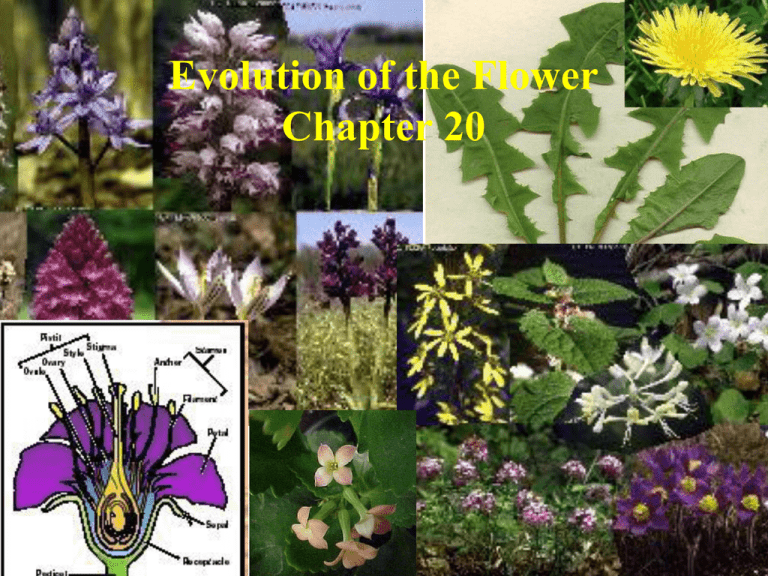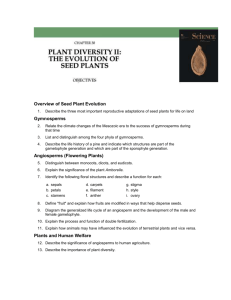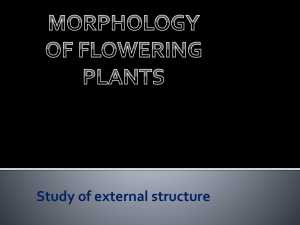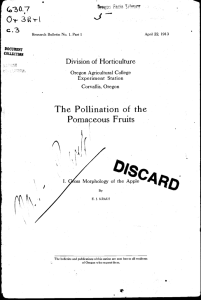Chapter 20 Evolution of Angiosperm
advertisement

Evolution of the Flower Chapter 20 • Two classes - Monocotyledons and Dicotyledons • Distinctive reproductive feature - carpels • Angiosperms enclose their seeds in structures known as carpels, instead of lying naked on the scales of a strobilus as in gymnosperms. Hence the name "angiosperm" which means "seed in vessel". Review of Flower Structure Flowers are reproductive structures that are formed from four sets of modified leaves on a shortened stem. In other words, the flower is a modified strobilus. Sepals - protect floral parts in the bud Petals - attract pollinators Stamens - anthers and filaments Carpels - stigma, style, and ovary (collection of carpels referred to as a pistil) The carpel is a unique structure found only in angiosperms. – Cut into the pistil and you will see one or more tiny chambers, each chamber holding one or more sporangia on tiny stalks. – These sporangia are the ovules - each carpel can hold one or several ovules – Ovules in the ovary develop into seeds • The ovary wall forms a fruit to help disperse the seeds • There is an amazing diversity of floral structures. Linnaeus used these differences to classify plants. Evolution of the Carpel • Goethe, German writer, philosopher, and (in his spare time) noted botanist, proposed in 1790 that carpels evolved from leaves. • Chambers in the pistil were probably formed from a sporophyll - a fertile leaf bearing ovules. • Sporophyll had ovules (modified sporangia) on its outer edges. • Edges of the leaf folded over and fused together to form a protective chamber - the carpel. • Pistils probably formed by the fusion of several carpels along the midrib of the modified leaves. • Goethe's "foliar theory of the carpel" is still the best hypothesis for explaining the evolution of the carpel. Derived Features of Angiosperms • Leaves with finely divided venation • Complex xylem - incl. vessels and parenchyma • Complex phloem - sieve tube elements w/companion cells • Herbaceous habit - rapid life cycle (some angios) • Ovary to protect ovules ("seeds in vessels") • Double fertilization and formation of triploid endosperm • Bisexual Flowers – microsporangia and megasporangia in same strobilus • Advanced pollination syndromes - insects, birds, etc. • Fruits to protect and diserse seeds • Extreme diversity in secondary metabolism Origin of the Angiosperms Darwin called the origin of the angiosperms an "abominable mystery". • The evolution of angiosperms remains a mystery to this day, although great progress has been made in recent years solving this mystery using a combination of fossil evidence, molecular data, and the discovery of the primitive angiosperm Amborella. • Flowering plants evolved sometime during the Cretaceous, approximately 140 million years ago, while the dinosaurs were at their peak. • However, no fossils showing a transition from gymnosperm to angiosperm have been discovered. This makes the origin of the angiosperms mysterious. • Angiosperms quickly became the dominant plants, although gymnosperms continued to rule in cold, dry, or sandy habitats, as they still do today. • Regardless of the origin of the angiosperms, by the end of the Cretaceous (65-70 mya) most flowering plant families had evolved. Pollination and Seed Dispersal • Coevolution occurs when an evolutionary change in one organism leads to an evolutionary change in another organism that interacts with it. • Flowering plants show two great examples of coevolution: evolution of animal pollination and evolution of fruit dispersal. • Flowers that rely on wind pollination are tiny and inconspicuous (like oak trees, maple trees, corn, grasses). • Flowers that are pollinated by animals have showy petals to attract the pollinators. • Flowers advertise their reward of nectar, sugar water, to attract pollinators. • Fruits function to disperse seeds. – Animals eat fruit, but don't digest seeds. – Tiny hooks and spines to attach to animal. – Also dispersed by wind, water (coconuts). Monocots or Eudicots? • Some flowering plants are neither monocots or dicots. • Magnolia Evolution of the flower • What were the flowers of the earliest angiosperms like? • Deduce their nature form what we know of certain living plants and from the fossil record. • In general flowers were diverse in the number of floral parts and in their arrangements. Parts of the flower provide clues to evolution • The perianth of early angiosperms did not have distinct sepals and petals • Sepals and petals were identical or there was a gradual transition in appearance between these whorls (magnolias and water lilies). • i.e. petals can be viewed as modified leaves that have become specialized for attracting pollinators. Wintergreen Chimphila umbellata In most angiosperms • Petals were probably derived originally from stamens that lost their sporangiabecoming sterile and modified to new role • Most petals like stamens are supplied by one vascular strand • In contrast sepals are normally supplied by the same number of vascular strands in a leaf • Petal fusion resulting in a tubular corolla figure 20-8c The Stamens • Magnoliids- broad, colored, and scented role in attracting floral visitors • In others- small greenish, fleshy • Many living angiosperm in contrast have thin filaments and thick terminal anthers • In stamens of monocots and eudicots are less diverse than Magnoliids Stamens continue • In some specialized flowers the stamens are fused together. • Form columnar structure i.e pea, melon and mallow fig 20-8d and sunflower 20-9d • Some stamens fused with corolla i.e. snapdragon, phlox, and mint families. Stamens can become nectaries • In some families stamens become sterile losing their sporangia and becoming specialized nectaries. • Nectaries are glands that secrete nectarsugary fluids tha tattract pollinators and provides food for them. • Most nectaries are not modified stamens but arose other ways. The Carpels • The carpels of many early angiosperms were unspecialized • Carpels with no specialized areas for the entrapment of pollen grains comparable to specialized stigmas of most living andiosperms. • Magnoliids- carpels are free from one another unlike most contemporary angiosperms. Four evolutionary trends among flowers are evident • Evolved toward having few parts that are definite in number • Floral whorls have been reduced four to one in more advance ones and the floral parts often have become fused. • Ovary has become inferior in position and the perianth has become differentiated into a distinct calyx and corolla • The radial symmetry (regularity) or actinomorphy of early flowers has given way to bilateral symmetry (irregularity)or zygomorphy in more advance ones. The Asteraceae and Orchidaceae are examples of specialized families Two largest families of angiosperms • Asteraceae- compositae which are eudicots • Orchidacea- monocots The flower of the Asteraceae are closely bunched together into a head • The epigynous flowers are relatively small and bunched together into a head • Each flower have an inferior ovary composed of two fused carpels with a single ovule in one locule Composite flowers • • • • Stamens are reduced to five in number Usually fused to one another (connate) And fused to the corolla (adnate) The petals also five are fused to one another and to the ovary • The sepals are absent or reduced to a series of bristles or scales (pappus) Pappus • Often serves as an aid to dispersal by wind Orchidaceae is the largest Angiosperm family • • • • • 24, 000 species Orchids Unlike composites are monocots individual species rarely abundant Most are tropical 140 native to US and Canada Orchids Orchids Like the composites: • The carpels are fused (The three carpels) • Ovary is inferior Unlike the composites: •Ovaries contain Animals serve as the primary agents of floral evolution • Flowers and insects have coevolved Wind pollination flowers produce no nectar Fruit is a Mature ovary • Accessory fruit- fruit which some additional parts are retained (strawberry) • Simple fruits develop from one carpel or from several united carpels. • Aggregate fruits, such as those magnolias, raspberries and strawberries consist of a number of separate carpels of one gynoecium • Multiple fruits consist of the gynoecia of more than one flower- the pineapple Simple fruits • May be – soft and fleshy, – dry and woody, or – papery Simple fruit fleshy fruits • Berries- tomatoes, dates, and grapes • Drupes- one to several carpels but only 1 seed- peaches, cherries, olives, plums • Pomes- example of an accessory fruitapples, pears Honeysuckle, Lonicera hispidula Dry simple fruit • Dehiscent- tissue of the mature ovary wall (the pericarp) break open freeing seeds • Indehiscent- the seeds remain in the fruit after the fruit has been shed from the parent plant. Dehiscent fruit, Legumes Cypselas, modified calyx (the Pappus) Poison Ivy Mescaline from the peyote cactus Cannabis sativa Quinine tx malaria Erythroxylum coca








